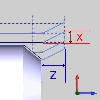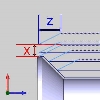 Leads
Leads
Introduction
Leads are an additional move added to the start and end of the cut. The Leads page handles both lead-in and lead-out moves for the following operations:
- Turning Rough
- Turning Basic Finish
- Pattern Repeat
This topic explains the lead parameters that are used for these operations types.
Lead-in
The Lead-in is an additional move prior to the initial cut into the material. The Lead-in allows you to specify how the cut is approached.
 Parallel
- creates a lead into the material that is parallel with the
toolpath move it is preceding.
Parallel
- creates a lead into the material that is parallel with the
toolpath move it is preceding.  Perpendicular
- creates a lead into the material that is perpendicular to
the toolpath move it is preceding.
Perpendicular
- creates a lead into the material that is perpendicular to
the toolpath move it is preceding. Horizontal
- creates a lead into the material that is parallel to the
center of rotation.
Horizontal
- creates a lead into the material that is parallel to the
center of rotation.  Vertical
- creates a lead into the material that is perpendicular to
the center rotation.
Vertical
- creates a lead into the material that is perpendicular to
the center rotation.  Angle
- creates a lead into the material that is at a 45 degree angle.
Angle
- creates a lead into the material that is at a 45 degree angle.  Custom
- creates a lead into the material that is dictated by the
values entered in the Lead-in Z, and Lead-in X boxes.
Custom
- creates a lead into the material that is dictated by the
values entered in the Lead-in Z, and Lead-in X boxes. 
Lead-out
The Lead-out is an additional move following the last cut in the material. The Lead-out allows you to specify how the tool exits the cut.
 Parallel
- creates a lead out of the material that is parallel with
the toolpath move preceding it.
Parallel
- creates a lead out of the material that is parallel with
the toolpath move preceding it.  Perpendicular
- creates a lead out of the material that is perpendicular
to the toolpath move preceding it.
Perpendicular
- creates a lead out of the material that is perpendicular
to the toolpath move preceding it. Horizontal
- creates a lead out of the material that is parallel to the
center of rotation.
Horizontal
- creates a lead out of the material that is parallel to the
center of rotation.  Vertical
- creates a lead out of the material that is perpendicular
to the center rotation.
Vertical
- creates a lead out of the material that is perpendicular
to the center rotation.  Angle
- creates a lead out of the material that is at a 45 degree
angle.
Angle
- creates a lead out of the material that is at a 45 degree
angle.  Custom
- creates a lead out of the material that is dictated by the
values entered in the Lead-out Z, and Lead-out X boxes.
Custom
- creates a lead out of the material that is dictated by the
values entered in the Lead-out Z, and Lead-out X boxes. 
Next Topic
After defining the leads for the last operation in the wizard, click Compute to close the wizard and create the toolpath. If you are in a Mill Turn job, click Next> > to go to the MDI page.






